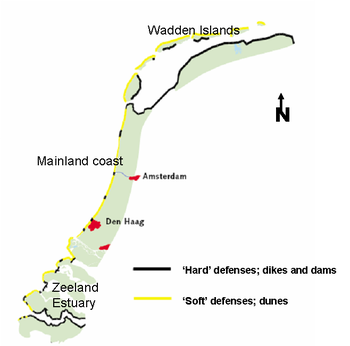| − | The determination of the [[bathymetry]] in coastal environments by utilizing the ocean wave-shoaling photographic imagery, and the observed reduction of ocean wave phase speed with decreased water depth, is used since the WW-II (Williams 1946)<ref>Williams, W.W. 1946, The determination of gradients of enemy-held beaches. Geographical Journal 107, 76–93.</ref>. The last decade, with the expansion of different ground based instrumentations, mainly radar and video imagery, for the observation of the sea surface and the exponential increase of the computational power, several methodologies for the [[bathymetry]] reckoning have been published, e.g. Bell 1999<ref> P. Bell 1999, Shallow water bathymetry derived from an analysis of x-band radar images of waves, Coastal Engineering 3-4, pp. 513-527.</ref>, Seemann et al. 1999<ref>Seemann J., C. Senet, H. Dankert, Hatten, H., Ziemer, F. 1999, Radar image sequence analysis of inhomogeneous water surfaces, in proc. of the SPIE'99 Conference - Applications of Digital Image Processing XXII. vol. 3808, pp. 536-546.</ref>, Stockdon and Holman 2000<ref>Stockdon, H.F., Holman, R.A. 2000, Estimation of wave phase speed and nearshore bathymetry from video imagery. Journal of Geophysical Research 105 (C9), pp. 22015–22033.</ref>, Dankert 2003<ref>Dankert, H. 2003, Retrieval of Surface-Current Fields and Bathymetries using Radar-Image Se-quences, International Geoscience and Remote Sensing Symposium, Toulouse, France.</ref>, Bell et al. 2004<ref name="bell">Bell, P., J. Williams, S. Clark, B. Morris and A. Vila-Concejo 2004, Nested Radar Systems for Remote Coastal Observations, Journal of Coastal Research SI39, pp. 483-487.</ref>, Catalan and Haller 2008<ref>Catalan, P.A. and Haller, M.C., 2008, Remote sensing of breaking wave phase speeds with ap-plication to non-linear depth inversions. Coastal Engineering, 55(1), pp. 93-111.</ref>, Senet et al. 2008<ref name="sen">Senet, C. M., J. Seemann, S. Flampouris, F. Ziemer 2008, Determination of Bathymetric and Current Maps by the Method DiSC Based on the Analysis of Nautical X–Band Radar-Image Se-quences of the Sea Surface, IEEE Transaction on Geoscience and Remote Sensing 46(7), pp.1-9.</ref>. The core of the previously mentioned methods is the inversion of the wave characteristics by assuming the validity of linear or non-linear models for the propagation of the wavefield over uneven sea bottom.
| + | Risk and probability are widely used in today's policies. It is also possible to adapt probabilistic design in coastal zone management. The risk of flooding poses a threat to present and future socio-economic activities. In this case risk can be defined as the probability of occurrence of an extreme event (storms, tsunamis) leading to erosion and flooding multiplied by the (socio-) economic damage caused by the storm event. The design water level of flood defences along the dutch coast are designed using the probabilistic approach. These levels are related to extreme storm surge water levels with a certain probability of occurrence. The level of the flood defence also on the value in the [[coastal hinterland|hinterland]]. Besides the design level, an probability of failure is taken into account. |
| − | In the present investigation, twelve hourly radar datasets acquired during storm conditions are analyzed by two methods: The non-linear method of Bell et al. 2004<ref name="bell"/> (henceforth BW04), which is based on the inversion of the non-linear [[Dispersion (waves)|wave dispersion]] equation of Hedges (1976)<ref>Hedges, T.S. 1976, An empirical modification to linear wave theory, Proc. Inst. Civ. Eng., 61, pp. 575-579.</ref> and the Dispersive Surface Classificator (henceforth DiSC08), Senet et al. 2008<ref name="sen"/>, which is based on the inversion of the linear wave theory. The results are validated as bathymetric retrieving instruments and the two wave propagation theories are compared about their sensitivity to the local bathymetric relief. The two methods are compared under the assumption of fundamentally similar implemented algorithms.
| |

